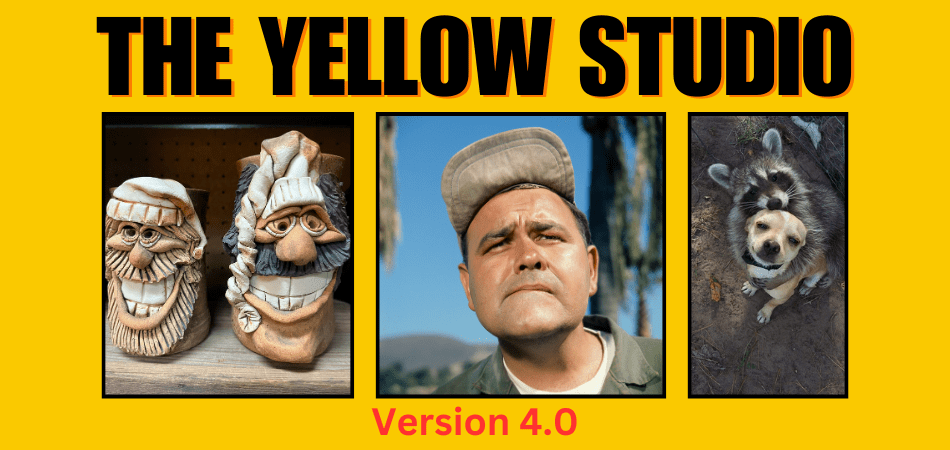
My podcasting “studio” continues to be a home studio. It started in a spare bedroom which had previously been my wife’s sewing room, but she outgrew it and occupied a bigger space (which she needed to hold all her sewing equipment, fabric, and other supplies). Around 1999/2000 I occupied it and converted it into The Yellow Studio. I posted this podcast episode at LeaningTowardWisdom.com to show people how I podcast (Version 1.0).
My workflow has never changed, despite the major changes in equipment. I use a broadcast workflow, meaning I prepare, prepare, prepare, and then I hit RECORD and go (incorporating minimal editing). The sound quality live has always been identical to the recorded. That’s the advantage of hardware over software. The disadvantage (at least in 1999)? Cost. Hardware used to cost much more than software.
Around 2018 I made another major change by ditching my 20-year-old Heil Sound PR40 dynamic mics (two, pictured here), and replacing them with large-diaphragm condenser mics. I don’t often recommend those to podcasters because most people don’t have a space that is acoustically suited for such mics. They pick up much more than dynamic mics. When they’re set up well, and proper mic technique is employed, they sound glorious though!
This is where I sat to produce my awesome podcasts through two versions of The Yellow Studio. 😉
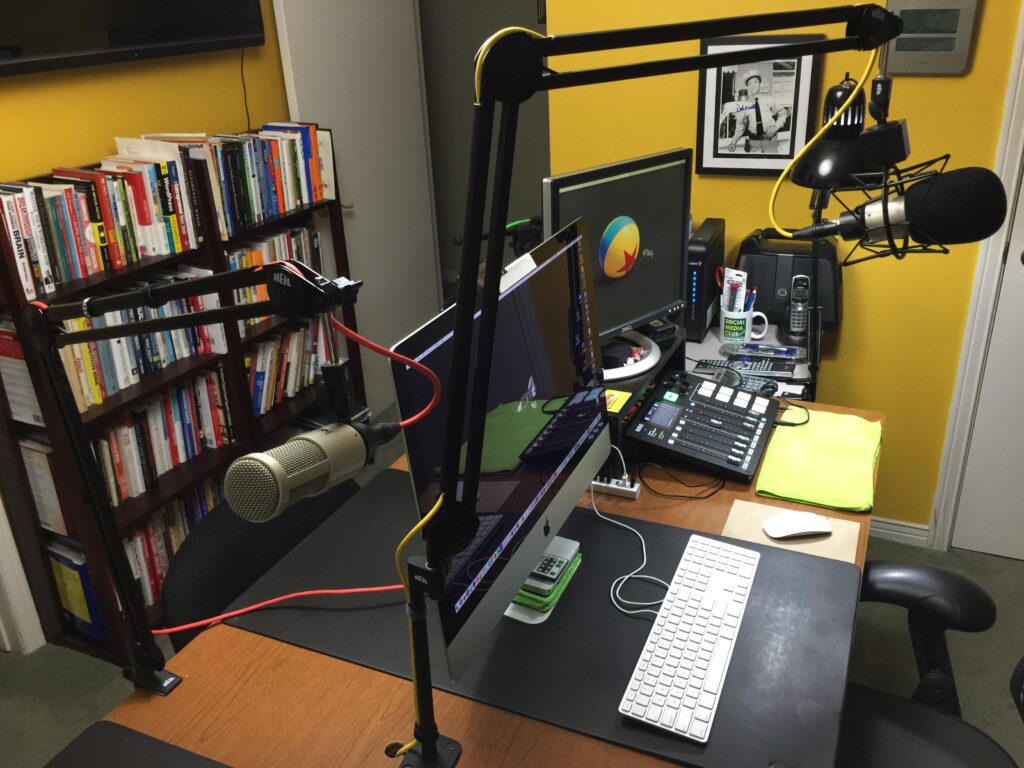
I went from a big rack of equipment to a single mixer. And I completely changed my microphones, too.
In 2023 we sold the house where the original Yellow Studio was, ending versions 1.0 and 2.0. Next came versions 3.0 and 3.1. The latter was merely a move from one room to a large walk-in closet, where the acoustics were glorious, but the inspiration was dreadful (clothes and shoes do not inspire me). Simultaneously, I was creating version 4.0 in a brand new location in Arkansas.
During the winter of 2023, I decided to make a mobile version of The Yellow Studio because I didn’t want two separate studios, even though I was devoting my time to two different places – one in Texas and one in Arkansas. Since the inspiration was highest in Arkansas – and the place was more spacious – I had begun building version 4.0 there. Besides version 3.2 was portable and involved less hardware.

3.2 consists of the Rode headset/mic combo and my laptop. It’s easy, sounds great and can be set up in minutes. I never podcast in Texas with anybody else unless it’s via Zoom, with a co-host.
4.0 is set up and ready to go at all times. You’ll see it all listed below.
Inside The Yellow Studio (Version 4.0)
The Heart/Brain
Apple Macbook Pro 2023 14″ M2 Pro with 32 GB RAM / 1TB Hard Drive and multiple Samsung T7 4TB SSD Drives
LG 27UN850 27″ monitor (main) and LG 29WQ600 Ultrawide monitor (extended monitor) – they’re cost-effective, high-quality, and ideal for me (I’m not a gamer)
Apple Magic Keyboard with Numeric Keypad
The Printer
Brother DCP-L2640DW Wireless Compact Monochrome Multi-Function Laser Printer
Lighting
Micomlan LED Desk Lamp with Clamp, Architect Desk Lamp for Home Office with Atmosphere Lighting, 24W Ultra Bright Auto Dimming Desk Light Stepless Dimming and Tempering LED Table Light (I love this desk light)
Elgato Key Light Air (2) (I use these for video recording)
Godox SL60IIBi Bi-Color LED Video Light
Aputure Lantern Softbox Soft Light Modifier,26inch, Quick-Setup Quick-Folding Aputure Space Light
Strobepro Dual Pistol Grip Roller Stand with 2 extra pistol grips
Strobepro Pivot Ball Head (2) for the stand
Strobepro Tripod Head Spigot Adapter for the stand
TJOY 2 Pack Led Corner Floor Lamp, Smart RGB Floor Lamp with app & remote (but I don’t use them as floor standing)
The Mixers
Rode Rodecaster Duo (for some in studio and field work)
The Recording Software (I’m on a Mac)
Apple Logic Studio
The Audio Plugin
I have others, but I never use them
Wavearts Dialog 2 (I use it occasionally to clean up audio, but rarely use it for my recordings)
The Microphones
Stellar X2 Large Diaphragm Condenser
Rode NT1 Large Diaphragm Condenser
Lewitt LCT-440-Pure Large-Diaphragm Condenser Microphone
Samson Go Mic Portable USB Condenser Microphone for Recording and Streaming on Computers
RØDE NTH-100M Professional Over-ear Headset
The Boom Arms
The XLR Cables
Kopul Premium Performance 3000 Series 15′ XLR cables in green, blue, yellow, and red
The Headphones
Beyerdynamic DT 770 PRO 80 Ohm Over-Ear Studio Headphones
Sony MDR-7506 Studio Headphones with improved pads by WC Wicked Cushions replacements
AKG Pro Audio K240 STUDIO Over-Ear, Semi-Open, Professional Studio Headphones
Sennheiser Professional HD 280 PRO Over-Ear
RØDE NTH-100M Professional Over-ear Headset
Power Management
Furman M-8X2 Merit Series 8 Outlet Power Conditioner and Surge Protector
The Field Recorder
The Field Microphones
Electro-Voice RE50B (two)
The Video Stuff
Insta360 Ace Pro action camera (my partner at HSVInsideOut.com keeps this to use)
NEEWER ND & CPL Filter Set for Insta360 Ace Pro
DJI Osmo Pocket 3 Creator Combo action camera (includes a wireless DJI microphone)
Magnetic ND Filters Set & Black Mist – Black Diffusion 1/4 Filter for DJI Osmo Pocket 3
CYNOVA DJI Osmo Pocket 3 Screen Protector
DJI Osmo Action 5 Pro Adventure Combo, Action Camera 4K
Skyreat Osmo Action 5 Pro Case, Portable PU Leather Carrying Case Shoulder Bag for DJI Osmo Action 5
Sony Alpha ZVE10 II – APS-C Interchangeable Lens Mirrorless Content Creators’ Camera
Sigma 16mm f/1.4 DC DN Contemporary Lens for Sony E (402965) Black
Ulanzi Silver Camera Cooling Fan w Spring Installation Flexible Mount for Sony ZVE10 II
SmallRig NP-FZ100 A7S III Dummy Battery Power Supply Adapter Kit for Sony ZVE10 II
Rode Wireless Pro two wireless mic system (my partner at HSVInsideOut.com keeps this to use)
Rode Interview Handles and windscreens (two, for the Wireless Pro system)
Ulanzi MT-16 mini-tripod/selfie stick
Ulanzi MT-79 long selfie stick/tripod (my partner at HSVInsideOut.com keeps this to use)
MOSISO Camera Backpack, DSLR/SLR/Mirrorless Photography Camera Bag 15-16 inch Waterproof Hardshell Case
military green (my partner at HSVInsideOut.com keeps this to use) / blue (the one I use)
JYJZPB NP-FZ100 Battery Replacement and A7iii Battery Charger for Sony ZVE10 II Battery, 2 Pack
I use Zoom video conferencing for recording remote guest conversations (when I do them).
Additionally, I’ve got some cartoons, artwork, knick-knacks, and more. For example…






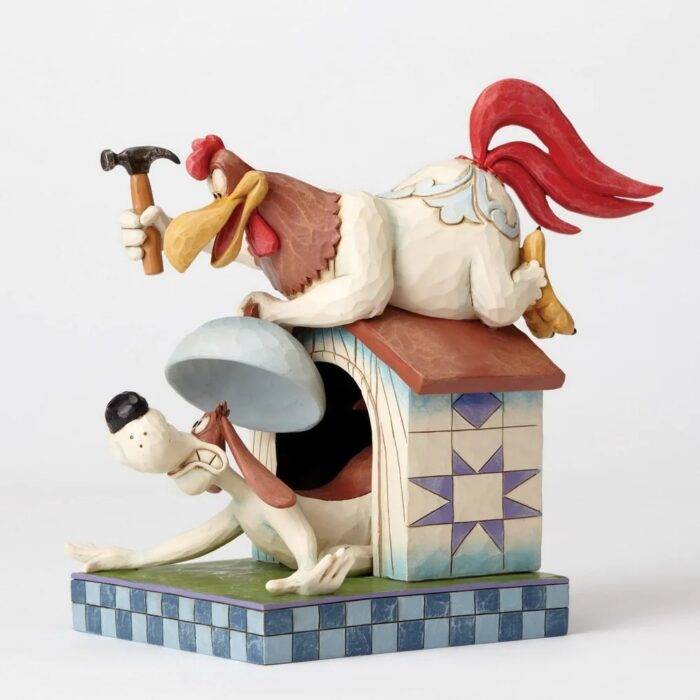
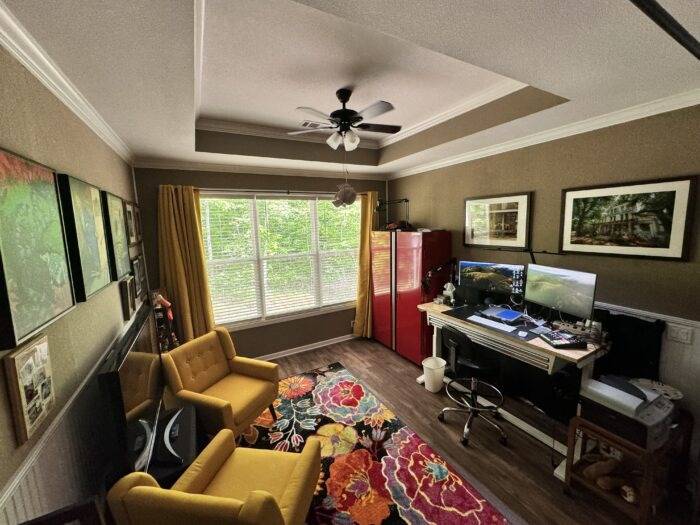
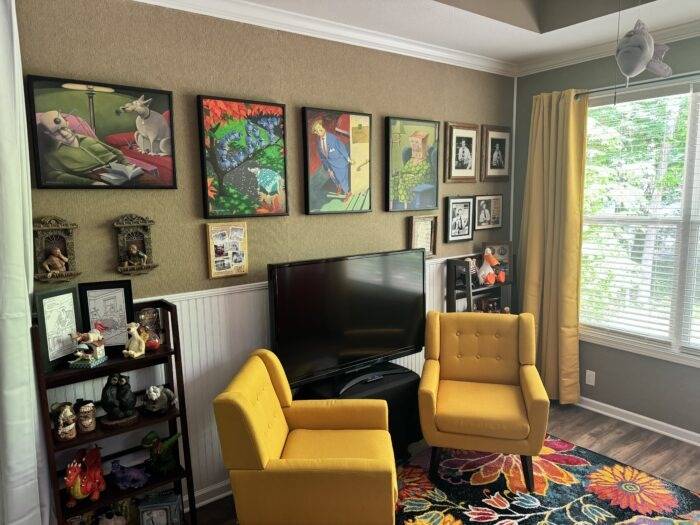
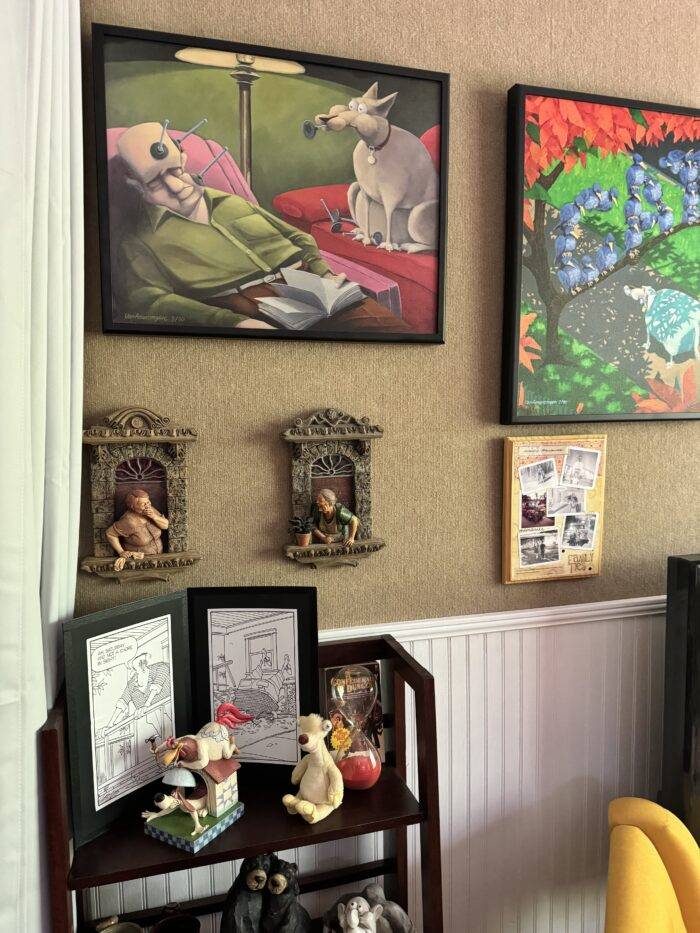
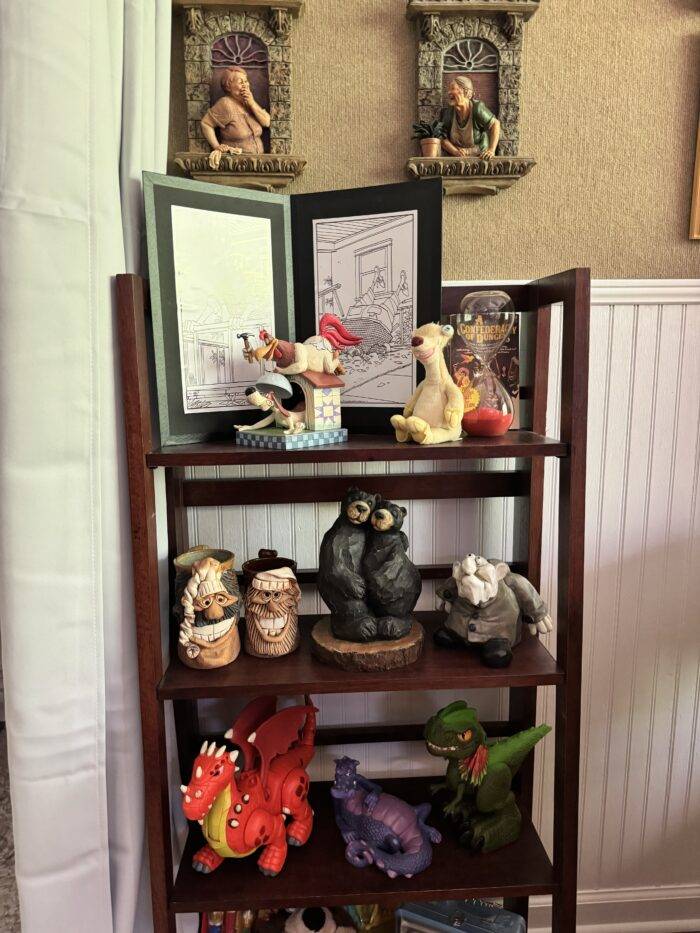
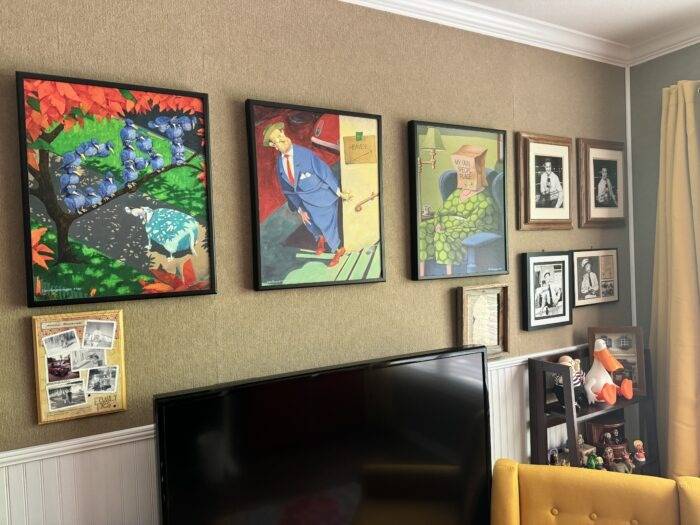
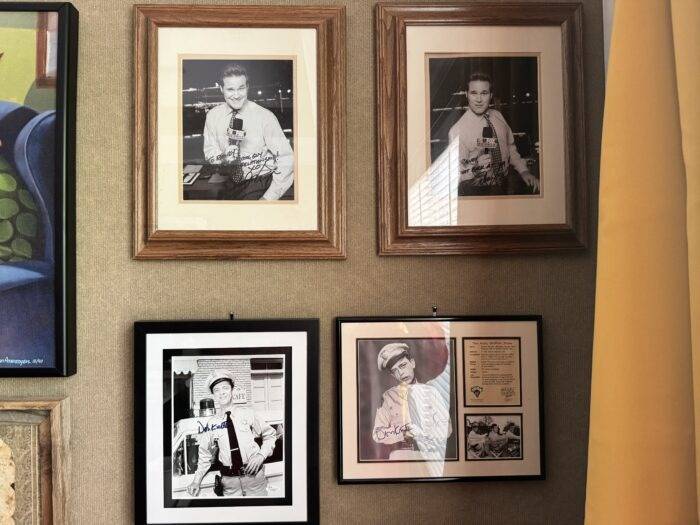
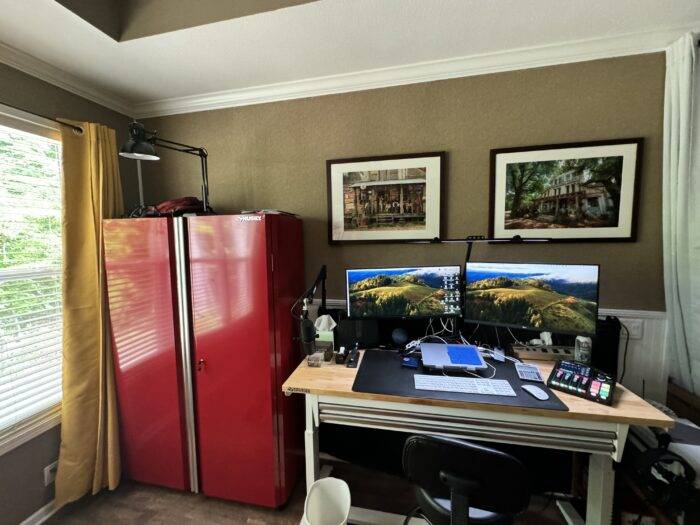
The Yellow Studio v4.0 (additional details)
- The space is 12 x 12, a three-sided room off a master bedroom with 10-foot ceilings
- Two parallel walls have no windows or doors; the 3rd wall has large windows, which are covered by acoustic/thermal “blackout” curtains that are almost ceiling to floor (they’re yellow) 😉
- Bead-board has been installed and painted (white), about 4 feet high on all three walls
- All three walls, including the wall space around the windows, have toffee-colored acoustical fabric installed. The fabric doesn’t reflect sound. It’s very effective in dampening echo.
- There’s a 6 x 9-foot multi-colored rug for even more sound dampening (the room is acoustically better than versions 1 and 2 of The Yellow Studio; version 3.1 is gonna be hard to beat ’cause was a walk-in closet) 😉
- Two yellow chairs are situated to create a new video recording space along one of the parallel walls
- The 72″ Husky Workbench, with 2 drawers is on the opposite parallel wall. That’s where the MacBook Pro resides with multiple wide-view monitors, the RodeCaster 2, power management, and external SSD hard drives.
- A Husky 48″ wide x 72″ tall red garage cabinet (with doors) sits next to the workbench (broadcast desk). This cabinet contains other gear, including microphones, along with miscellaneous cables, connectors, and other items necessary to keep The Yellow Studio operational.
- A small round table sits between the two yellow chairs with a 55″ Mitsubishi flat-panel TV on top
- Four Ballard Street prints hang on the wall behind the chairs
- Two photos hang above my desk – the 1939 storefront and the photo of the Magnolia Pearl in Fredericksburg, Texas
Use the contact page if you have any questions. I’m happy to answer them.
